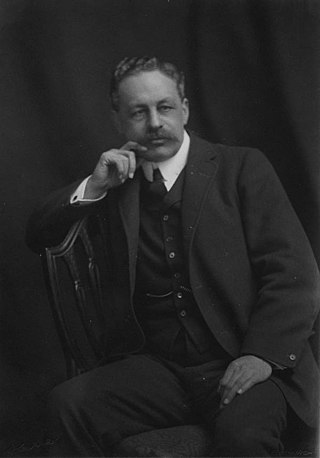Geopolitics is the study of the effects of Earth's geography on politics and international relations. While geopolitics usually refers to countries and relations between them, it may also focus on two other kinds of states: de facto independent states with limited international recognition and relations between sub-national geopolitical entities, such as the federated states that make up a federation, confederation, or a quasi-federal system.

Sir Halford John Mackinder was a British geographer, academic and politician, who is regarded as one of the founding fathers of both geopolitics and geostrategy. He was the first Principal of University Extension College, Reading from 1892 to 1903, and Director of the London School of Economics from 1903 to 1908. While continuing his academic career part-time, he was also the Conservative and Unionist Member of Parliament for Glasgow Camlachie from 1910 to 1922. From 1923, he was Professor of Geography at the London School of Economics.
Grand strategy or high strategy is a state's strategy of how means can be used to advance and achieve national interests in the long-term. Issues of grand strategy typically include the choice of military doctrine, force structure and alliances, as well as economic relations, diplomatic behavior, and methods to extract or mobilize resources.
Geostrategy, a subfield of geopolitics, is a type of foreign policy guided principally by geographical factors as they inform, constrain, or affect political and military planning. As with all strategies, geostrategy is concerned with matching means to ends Strategy is as intertwined with geography as geography is with nationhood, or as Colin S. Gray and Geoffrey Sloan state it, "[geography is] the mother of strategy."
Geopolitik was a German school of geopolitics which existed between the late 19th century and World War II.

Robert David Kaplan is an American author. His books are on politics, primarily foreign affairs, and travel. His work over three decades has appeared in The Atlantic, The Washington Post, The New York Times, The New Republic, The National Interest, Foreign Affairs and The Wall Street Journal, among other publications.
Political geography is concerned with the study of both the spatially uneven outcomes of political processes and the ways in which political processes are themselves affected by spatial structures. Conventionally, for the purposes of analysis, political geography adopts a three-scale structure with the study of the state at the centre, the study of international relations above it, and the study of localities below it. The primary concerns of the subdiscipline can be summarized as the inter-relationships between people, state, and territory.

The Rimland is a concept championed in the early 20th century by Nicholas John Spykman, professor of international relations at Yale University. To him, geopolitics is the planning of the security policy of a country in terms of its geographical factors. He described the maritime fringe of a country or continent; in particular the densely populated western, southern, and eastern edges of the Eurasian continent.

Realism, a school of thought in international relations theory, is a theoretical framework that views world politics as an enduring competition among self-interested states vying for power and positioning within an anarchic global system devoid of a centralized authority. It centers on states as rational primary actors navigating a system shaped by power politics, national interest, and a pursuit of security and self-preservation.

Gilford John Ikenberry is a theorist of international relations and United States foreign policy, and the Albert G. Milbank Professor of Politics and International Affairs at Princeton University. He is known for his work on liberal International Relations theory, such as the books After Victory (2001) and Liberal Leviathan (2011). He has been described as "the world's leading scholar of the liberal international order."

"The Geographical Pivot of History" is an article submitted by Halford John Mackinder in 1904 to the Royal Geographical Society that advances his heartland theory. In this article, Mackinder extended the scope of geopolitical analysis to encompass the entire globe. He defined Afro-Eurasia as the "world island" and its "heartland" as the area east of the Volga, south of the Arctic, west of the Yangtze, and north of the Himalayas. Due to its strategic location and natural resources, Mackinder argued that whoever controlled the "heartland" could control the world.
Offensive realism is a structural theory in international relations that belongs to the neorealist school of thought and was put forward by the political scholar John Mearsheimer in response to defensive realism. Offensive realism holds that the anarchic nature of the international system is responsible for the promotion of aggressive state behavior in international politics. The theory fundamentally differs from defensive realism by depicting great powers as power-maximizing revisionists privileging buck-passing and self-promotion over balancing strategies in their consistent aim to dominate the international system. The theory brings important alternative contributions for the study and understanding of international relations but remains the subject of criticism.

The balance of power theory in international relations suggests that states may secure their survival by preventing any one state from gaining enough military power to dominate all others. If one state becomes much stronger, the theory predicts it will take advantage of its weaker neighbors, thereby driving them to unite in a defensive coalition. Some realists maintain that a balance-of-power system is more stable than one with a dominant state, as aggression is unprofitable when there is equilibrium of power between rival coalitions.

The Grand Chessboard: American Primacy and Its Geostrategic Imperatives (1997) is one of the major works of Zbigniew Brzezinski. Brzezinski graduated with a PhD from Harvard University in 1953 and became Professor of American Foreign Policy at Johns Hopkins University. He was later the United States National Security Advisor from 1977 to 1981, under the administration of President Jimmy Carter.
Neoclassical realism is a theory of international relations and an approach to foreign policy analysis. Initially coined by Gideon Rose in a 1998 World Politics review article, it is a combination of classical realist and neorealist – particularly defensive realist – theories.

Arnold Oscar Wolfers was a Swiss-American lawyer, economist, historian, and international relations scholar, most known for his work at Yale University and for being a pioneer of classical international relations realism.
The Yale Institute of International Studies was a research institute that was part of Yale University in New Haven, Connecticut. It was founded in 1935 and was led by directors Nicholas J. Spykman and later Frederick S. Dunn, under whom there was also an associate director, William T. R. Fox. The institute was influential in the development of international relations theory; in particular, it was considered a bastion of international relations realism. The institute came to an end in 1951 due to a conflict with the university administration. Dunn and five of his colleagues left Yale and formed a successor organization, the Center of International Studies, at Princeton University that same year.

Frederick Sherwood Dunn was an American scholar of international law and international relations. After working as a legal officer at the U.S. Department of State, he went into academia and taught at Johns Hopkins University, Yale University, and Princeton University, publishing several books during his career. He was founder and a director of both Yale's Institute of International Studies and the Center of International Studies at Princeton. He founded the journal World Politics and was chairman of its editorial board until 1961.
Richard Edes Harrison was an American scientific illustrator and cartographer. He was the house cartographer of Fortune and a consultant at Life for almost two decades. He played a key role in "challenging cartographic perspectives and attempting to change spatial thinking on the everyday level during America’s rise to superpower status". Susan Schulten considers Harrison's maps "critical to the history of American cartography."
Geostrategy in Taiwan refers to the foreign relations of Taiwan in the context of the geography of Taiwan. Taiwan is an island country in East Asia, while it is also located at the center of the first island chain and commands the busy traffic of Taiwan Strait and Bashi Channel.








